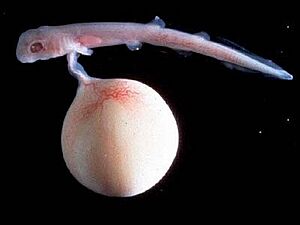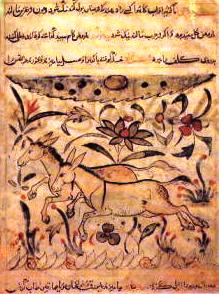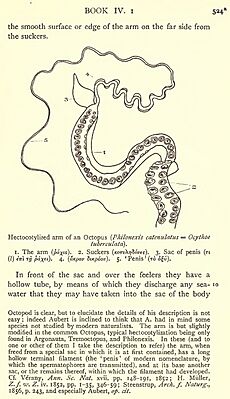History of Animals facts for kids

History of Animals is a very old and important book about animals. It was written by the famous Greek thinker Aristotle around 300 BC. He studied at Plato's Academy in Athens. This book is seen as one of the first major works in zoology, which is the study of animals.
Aristotle wanted to understand animals by first looking at what they were like (their features). Then, he tried to figure out why they had those features. He looked for differences between animals and between groups of animals. For example, he noticed that all birds have feathers, wings, and beaks. This idea, that a whole group shares certain features, was very important.
The History of Animals has many accurate observations. Aristotle carefully watched sea creatures around the island of Lesbos. He saw that octopuses could change their color. He also noted that young dogfish grow inside their mother. He even observed that the male river catfish guards its eggs after the female leaves. Some of his observations were thought to be made-up for a long time, but scientists later found them to be true. While Aristotle sometimes used information from travelers or beekeepers without checking it, his work was groundbreaking.
This book greatly influenced the study of animals for about 2,000 years. It was the main source of animal knowledge until the 1500s. Later zoologists, like Conrad Gessner, were inspired by Aristotle to write their own animal studies.
Contents
Who Was Aristotle?
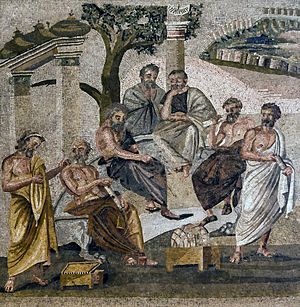
Aristotle lived from 384 to 322 BC. He spent about 17 years studying at Plato's Academy in Athens. Like Plato, Aristotle looked for general truths in his thinking. But Aristotle also focused on detailed observations. He especially studied the natural history of the island of Lesbos. He also looked closely at the sea life in the lagoon at Pyrrha.
This careful study made him the first natural historian whose writings we still have today. No other detailed book on zoology was written until the 1500s. Because of this, Aristotle remained very important for about two thousand years. His writings about animals make up about a quarter of all his surviving works. Aristotle's student, Theophrastus, later wrote a similar book about plants called Enquiry into Plants.
How Aristotle Studied Animals
In the History of Animals, Aristotle wanted to find out the facts about animals first. He called this the "what." After that, he tried to understand the reasons for these facts. He called this the "why." So, his book explains his way of studying zoology.
Aristotle looked at four main types of differences between animals:
- Differences in specific body parts (Books I to IV).
- Differences in how they live and what they do (Books V, VI, VII, and IX).
- Differences in special characteristics (Book VIII).
To explain his method, think about a group like 'birds'. All birds have the same special features: feathers, wings, beaks, and two bony legs. This is an example of a general rule. If something is a bird, it has feathers and wings. And if something has feathers and wings, it is likely a bird.
Aristotle was mostly interested in describing animal features. There is some discussion among experts about whether he was also trying to create a system for classifying animals. Most philosophers think he wasn't trying to make a full classification system. But some modern biologists have different ideas.
What's Inside the Book?
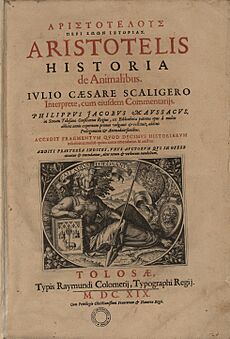
Here's a quick look at what you can find in each part of the History of Animals:
Book I This part talks about how animals are grouped. It also describes the parts of the human body, like the skull, brain, eyes, ears, and limbs.
Book II Aristotle describes the different parts of animals that have red blood. He writes about the limbs and teeth of dogs, horses, humans, and elephants. He also looks at animals like apes, crocodiles, chameleons, birds (especially the wryneck), fish, and snakes.
Book III This book covers the internal organs of animals. This includes the systems for reproduction, veins, muscles, and bones.
Book IV This section focuses on animals without blood, which we now call invertebrates. These include cephalopods (like octopuses) and crustaceans (like crabs). He also describes the sense organs of animals. He even wonders if fish sleep.
Books V and VI These books discuss how different animals reproduce. This includes sea invertebrates, birds, four-legged animals, snakes, fish, and land insects. He mentions insects like ichneumon wasps, bees, ants, scorpions, spiders, and grasshoppers.
Book VII This part is all about human reproduction. It covers puberty, getting pregnant, pregnancy, breastfeeding, the baby's development, birth, and common illnesses in babies.
Book VIII Aristotle explores the behavior and habits of animals. He writes about what they eat, how they migrate, their health, and animal diseases. He even mentions bee parasites and how climate affects animals.
Book IX This book looks at how animals behave in groups. It also talks about signs of intelligence in animals like sheep and birds.
Some versions of the book include a tenth part. However, most experts agree that Aristotle did not write this part. It discusses why some women cannot have children.
Amazing Observations
The History of Animals is full of detailed observations. Many of these are about marine biology, which is the study of sea life. This is very different from Plato's more symbolic way of looking at animals. Aristotle's careful style can be seen when he talks about cephalopods (like octopuses and cuttlefish). He mentions how they use ink to escape predators, how they camouflage themselves, and how they communicate.
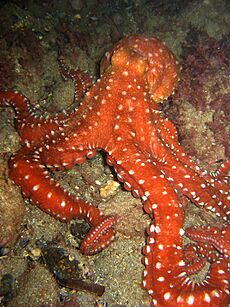
Here's what he wrote about the cuttlefish and octopus: "Of molluscs the cuttlefish is the most cunning. It is the only one that uses its dark liquid to hide, not just out of fear. The octopus and squid only release ink when scared. These creatures never use all their ink. After they release it, more ink grows back. The cuttlefish often uses its ink to hide. It shows itself in front of the ink and then hides back in it. It also hunts with its long tentacles, catching small fish and even mullets. The octopus is a simple creature, as it will approach a human's hand if it's in the water. But it is tidy and careful in its habits. It stores food in its nest. After eating everything edible, it throws out the shells of crabs and shellfish, and the bones of small fish. It hunts by changing its color to match the nearby stones. It also does this when it is scared."
Most of Aristotle's observations were very accurate. However, some experts believe that sometimes his ideas might have influenced what he thought he saw.
Some of Aristotle's observations were not believed by scientists until they were proven true in the 1800s. For example, Aristotle wrote that a river catfish (which he called the glanis) takes care of its young. The female leaves after laying eggs. The male then guards the eggs for 40 to 50 days. He chases away small fish that threaten the eggs and makes a murmuring sound. A scientist named Louis Agassiz confirmed this in 1890.
Aristotle used methods like dissection to study animal anatomy directly. He even had a lost book called The Dissections with drawings. But sometimes, his ideas about what body parts did were wrong. Like other ancient writers, Aristotle also got information from travelers and people with special skills, such as fishermen and beekeepers. He didn't always check if their stories were true.
Were There Mistakes?
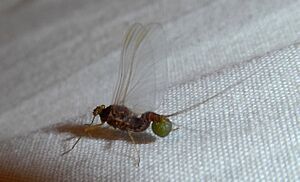
The book does contain some statements that seem incorrect. For example, Aristotle wrote in Book II that female humans, sheep, goats, and pigs have fewer teeth than males. This claim seems false. However, some suggest that women in his time might have had poorer diets, which could affect tooth development. But the claim isn't true for other animals either. So, some argue that Aristotle was good at observing, but he wasn't always strict about checking every detail.
In other cases, mistakes might have been wrongly blamed on Aristotle. Some people said he claimed that flies have four legs. This idea was repeated in books for over a thousand years, even though it's easy to count a fly's legs and see they have six. However, a historian named John S. Wilkins points out that Aristotle didn't say "all flies have four legs." He wrote that a specific insect, the ephemeron or mayfly, "moves with four feet and four wings." Mayflies actually do walk on four legs, as their front pair of legs are not used for walking. So, Aristotle was correct about the mayfly!
More generally, Aristotle's ideas about biology, found in his books sometimes called On Animals, were like early scientific models. They tried to explain how animals work, how they get energy, control their temperature, process information, and how they inherit traits. While modern science has different models, Aristotle's ideas were scientific for his time. They tried to explain what he observed, suggested how things worked, and made predictions that could be tested.
How the Book Spread
The History of Animals was translated into Arabic. It became parts 1–10 of the Kitāb al-Hayawān (The Book of Animals). This Arabic version was known to the Arab philosopher Al-Kindī around 850 AD. Other thinkers like Avicenna wrote comments on it. Later, in the early 1200s, this Arabic version was translated into Latin, along with comments by Ibn Rushd (Averroes).
In English, translations were made by Richard Cresswell in 1862 and by the zoologist D'Arcy Wentworth Thompson in 1910. There were also French and German translations, helping the book reach many more readers.
Its Lasting Impact
The comparative anatomist Richard Owen said in 1837 that "Zoological Science sprang from [Aristotle's] labours... in a state of noble and splendid maturity." This means that the study of animals really began with Aristotle's hard work.
Ben Waggoner, from the University of California Museum of Paleontology, wrote that: "Even though Aristotle's work in zoology had some mistakes, it was the greatest collection of biological knowledge of its time. It remained the most important source for many centuries after he died. His observations on the anatomy of octopus, cuttlefish, crustaceans, and many other sea invertebrates are amazingly accurate. He could only have made them by dissecting these animals himself. Aristotle described how a chick develops from an egg. He knew that whales and dolphins were different from fish. He described the special stomachs of animals like cows that chew their cud. He also noted the social life of bees. He even saw that some sharks give birth to live young. His books on animals are full of such observations, and some were not confirmed until many centuries later."
Aristotle "clearly influenced" the people who started modern zoology. These included the Swiss Conrad Gessner, the Italian Ulisse Aldrovandi, the French Guillaume Rondelet, and the Dutch Volcher Coiter. His ways of looking at changes over time and comparing animal bodies also helped the Englishman William Harvey in his work on how embryos develop in 1651.
A 2014 book called The Lagoon: How Aristotle Invented Science by Armand Marie Leroi and a BBC show called Aristotle's Lagoon explain Aristotle's biological writings, including the History of Animals, and how his ideas shaped science.
See also
 In Spanish: Historia de los animales para niños
In Spanish: Historia de los animales para niños


